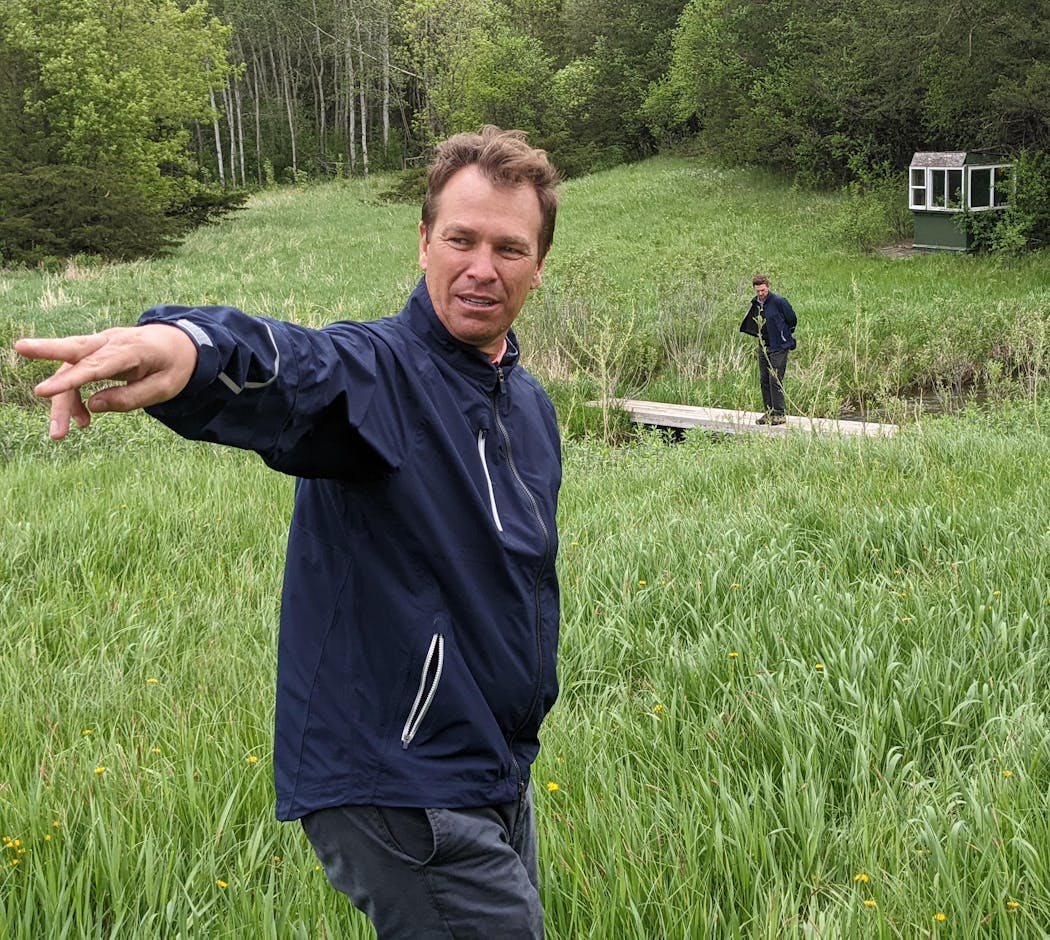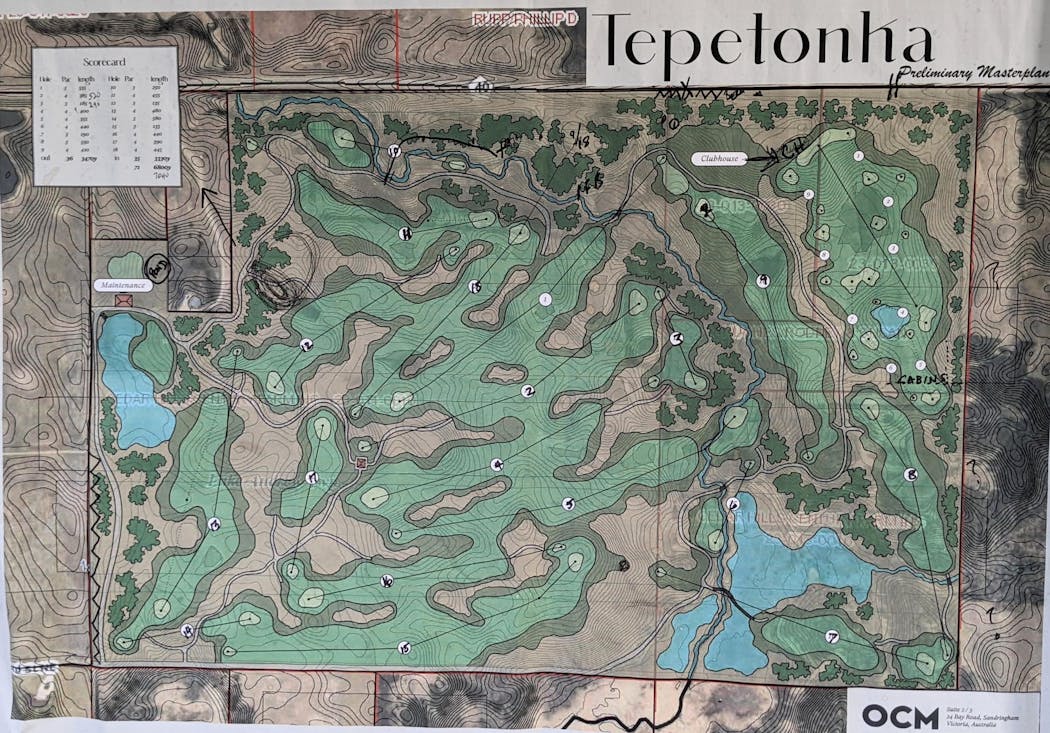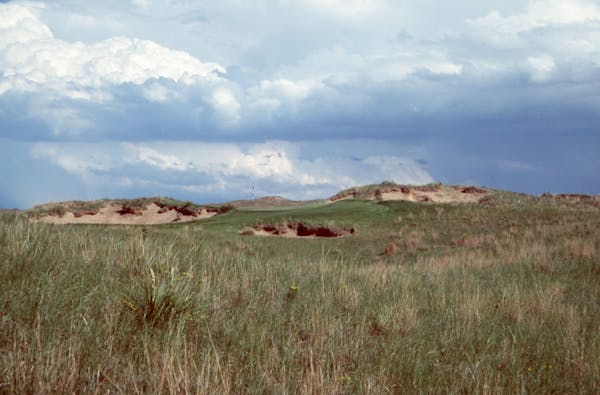NEW LONDON, MINN. – After a three-year search took him north near Brainerd, east to Eau Claire and west toward South Dakota, Mark Haugejorde found the tumbling land he sought for a remote "destination" private golf club he says Minnesota lacks.
It was five miles from his childhood home.
The former Chicago real-estate investment banker — and New London-Spicer's 1973 Minnesota high school state golf co-champion — traveled a Kandiyohi County road he knew from hunting pheasant and saw a ravine and creek he didn't recall.
So he turned left down a dead-end gravel road on a Sunday spring morning a year ago and drove a half-mile more. He marked the location and time — 8:28 a.m., May 23, 2021 — on a hunting app.
"I pulled over and said, 'There it is,' " he said.
That "it" is 228 acres of undulating former farmland made by nature for golf.
Land made for golf is what has created stay-and-play courses — most of them private clubs — and discerning clienteles paying large membership fees. They have sprung up these past 25 years mostly on sandy soils from Colorado's eastern plains and Nebraska's sandhills to Wisconsin's ancient glacial lakes.
It is also what convinced Haugejorde that 100 golfers from near and far will pay a six-figure membership fee to join the Tepetonka Club, named after a resort on nearby Green Lake a century ago.
Four years ago, Haugejorde played one of those destination courses — Nebraska's famed Sand Hills — with former longtime Hazeltine National head pro Mike Schultz, Haugejorde's pro-shop boss back in his college days.
They asked each other why Minnesota — with all its great private metro clubs and public-resort courses in Brainerd and Giants Ridge — didn't have something like that. Golfweek rates Sand Hills the best modern American course built since 1960.
"There are states all around us, like a horseshoe, that have these places to go stay-and-play," said Haugejorde, who played college golf at Houston with Jim Nantz, Fred Couples and briefly Nick Faldo. "And we don't have any."
A natural
So far, Tepetonka's 18-hole and short courses are routed only on paper and staked in the earth by Australian course-design company OCM Golf Course Design — the O for 2006 U.S. Open champion Geoff Ogilvy — that will move very little dirt except for the construction of greens and tees.
Ogilvy and colleagues Mike Cocking and Ashley Mead spent five cold, snow-blown days in April walking the property, allowing a course to reveal itself after they got the job. Cocking and Mead returned in May and all three will come back in July during the 3M Open after deciding where bunkers will be built, and how many.
"The first thing I did was look at a map to see where New London was," Ogilvy wrote by e-mail. "I'd been through Minneapolis a few times, but truth be told, I really had no idea where it was."
Construction for a course that will be primarily a walking one with a caddie program is set to begin next spring after an environmental assessment and permits are completed. Opening is scheduled for summer 2024.
Those 228 acres feature bluffs and 50-foot elevation changes, distinctive cedar trees smattered on the hilltops and flowing Shakopee Creek that will come into play on seven holes at a course where the wind usually blows.
It's almost as if the moraines deposited by receding glaciers more than 10,000 years ago were left there specifically to route fairways over and among.
"It's not almost," Haugejorde said. "They are."
A year after Haugejorde's discovery, three siblings who together own 187 acres of the site are disputing among themselves the $1.2 million land sale. One filed a civil lawsuit against the other two alleging, among other things, they agreed to sell the land at a "significant discount" and didn't have the property appraised. A hearing is scheduled for September.
Haugejorde said the club has a binding purchase agreement and a license to access the property as planning and permitting work to build the two courses, clubhouse, creekside cabins, dining, game room, wine cellar and more proceeds. Environmental, engineering and course design teams all have been working on-site, he said.
Haugejorde said a club that's "exclusive but not exclusionary" will be all about business networking and philanthropy.
He envisions the club will host college tournaments and PGA section events on a course lined with native prairie grasses. It's intended to play firm and bouncy, like a seaside links course.
"It could be in the UK," Cocking said.
In his own backyard
The first of 20 sold-out founding members paying an introductory $100,000 each have joined Tepetonka Club, Haugejorde said. The fee is set to increase 20 members at a time until membership is capped at 100.
Haugejorde said he expects about 60 members from the Twin Cities, 20 from outstate Minnesota and 20 from out of state. Most already belong to other private clubs. He belongs to Windsong Farm locally and a collection of private clubs nationally called the Dormie Network that is planning a new one in Nebraska's sandhills called Graybull.
Some will fly on private planes into nearby Willmar airport from their southern homes, seeking to beat the summer heat for a day or three, just as Minnesotans escape winters in Arizona and Florida. Its golf season will be roughly Memorial Day into October every year about a two-hour drive from the Twin Cities.
Ogilvy had seen the topographical maps, photographs and drone video before he first walked the property for five cold, snowy, windy days in April with his partners. They worked out a routing the first four days, then turned it all around the night before they presented it to Haugejorde.
When asked how long it took to reach the routing, Cocking replied, "Twenty-two years." He and Mead started their company in 2000.
"You try to identify the land that looks like good golf, what's interesting, and what doesn't look like golf," Mead said about a process all about contours and angles.
Before he left, Ogilvy quipped he'd never experienced a White Christmas before but now knows a White Easter. He called the spring weather "amazing for three guys from Australia" and the land from which his crew builds holes out of the ground more than he expected.
"You never really know for sure until you see it and walk around it," Ogilvy wrote. "We loved what we found, even in the crazy weather we experienced. Holes just appearing as we wandered about."
Their firm is based among Australia's great sand-belt courses in and around Melbourne. Its American work includes renovations of Ben Hogan's Shady Oaks in Texas and U.S. Open, Ryder Cup and 2026 Presidents Cup site Medinah 3 near Chicago.
Haugejorde talked to representatives with Tiger Woods and Jack Nicklaus design firms but took pro golfer and pal Tim Herron's advice, among others, and hired the three respected Australian designers.
Haugejorde worked for Nicklaus' companies for seven years, marketing Jack's brand worldwide while he observed how the organization built hundreds of courses.
He calls himself Tepetonka's "club captain," and is responsible for project management and membership development with Schultz his "chief question officer."
His father started Little Crow golf resort in Spicer in the 1960s. His five sisters all play, as still does his 93-year-old mother. Haugejorde had some time before his 11 a.m. tee time with his mom that Sunday morning last year when he turned off that county road and saw it unlike any site ruled out because it wasn't special enough.
"We found something beyond our wildest imaginations in any area," he said, "let alone our backyard where we grew up."

Byron Buxton drives in five runs as Twins trounce A's

Twins' Lewis searches for his way out of another hitting slump

On Vikings' rebuilt D-line, less playing time may be a good thing
Jefferson says he knows his presence at Vikings OTAs 'makes a difference'




